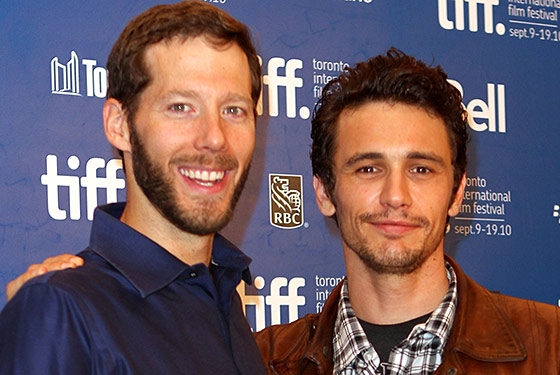
Feel like passing out during a screening of Danny Boyle’s upcoming 127 Hours, in which James Franco stars as Aron Ralston, the real-life mountain climber who amputated his own arm in 2003 after it got stuck under a boulder? Ralston has some advice: “Stay seated,” he told Vulture last week, following a Vanity Fair screening of the film. “It’s okay if you’re in your seat and you feel like you need to pass out for a few seconds. It only becomes dangerous if you decide you need to leave the theater and you stand up and then you’re falling from a standing position.”
Franco gave us this tip: “If you’re feeling woozy, just cover your eyes. There’s nothing wrong with covering your eyes. It took 40 minutes [for Aron to cut his arm off], so what Danny showed is mercifully short. It’s visceral, but it’s about the exhilaration of getting free and leaving in the end.”
For his part, Boyle wishes people would just stop writing so much about 127 Hours’ fainting victims. “The danger is that it becomes the be all and end all of seeing the movie,” he told us, after participating in a post-screening Q&A with Franco and Ralston. “What follows [the amputation scene] is a moment of redemption where he enters into the sunlight. People should see it in that context. I hope it doesn’t put people off who feel that they might get too distressed by it. It’s not distressing in that sense, but it is intense.”
Besides, “it’s a tiny number of people” fainting, Boyle said. “And I’ve been shocked that we don’t have walkouts. I thought people would be unable to sit through it. But most people not only get through it, but enjoy getting to the other side. It’s not enjoyable in the conventional sense of the word, but it’s a rite of passage that goes on during the film, during the journey of this guy, and I hope people can enjoy the whole movement of the film toward that. And also the redemptive or feel-good ending, the euphoria that he feels — which Aron called an ecstasy, really — is incredibly deeply felt because of the experience you’ve been through. It’s no cheap thrill.”
According to James Franco, faintings at screenings might actually be a good sign. “It’s meant to be an intense, personal, immersive experience. This isn’t a horror film. It’s not Saw, where you go into it knowing that half the people you meet at the beginning are going to be dead by the end, so you don’t form an attachment,” Franco told us. “Here, you’re spending the entire movie with one guy. You, as the audience, are going through it with Aron. When you watch the footage of him talking into that video camera to his family, you feel like he’s talking directly to you. And when he cuts off his arm, maybe it feels like it’s happening to you.”
Franco certainly felt like it was happening to him. “It was emotionally and physically demanding role. I’ve done intense roles before and I thought it would be fine. But when I got to the scene where I do it, I lost it,” he told us. The arm-cutting scene involved three prosthetic arms, one made to look exactly like the outside of Franco’s own arm, and two filled with all the musculature and bone he had to chop through. “I actually have a problem with blood. It’s only my arms; I have a problem with seeing blood on my arm,” he told us. “So after the first day, I said to Danny, ‘I think you got the real, unvarnished reaction there.’” The prosthetic had actually been made so that Franco wasn’t supposed to be able to cut all the way through it. But in the moment, he said, “I just did it, and I cut it off and I fell back, and I guess that’s the take that Danny used.”
For Ralston, the most important part was making sure the mood of the moment was right, particularly when he figures out that if he breaks the bones in his arm, he can cut through the flesh. “Aron told me that, yes, it was a very painful thing to do, but there was also exhilaration. He had been there for days not knowing how to get out and suddenly he had a solution,” said Franco. “You can see that smile. It really was a triumphant moment. I was smiling when I did it,” said Ralston. “I had to hound the team to make sure that smile made it into the film, but I’m really happy that it did. That really speaks about the motivation. This is something we want to see him doing. Me, I wanted to do that.”
Ralston has been back to that canyon ten times or so since his entrapment; the first time was six months after he got out of the ICU, when he brought the ashes of his cremated hand and scattered them there. And he’s seen the movie over half a dozen times. He said that everything you see onscreen, the arrogant, selfish guy who goes into that canyon and the grateful man who walks out, having spent days in this beautiful remote place without humans, trying to reach out to other humans in his life via a camcorder, is true. “It’s not a nightmare at all. It’s perhaps the most beautiful story I’ll get to experience in my life,” he said. “It’s a true blessing for me, giving this gift to the team who is now giving it to the world. For me, it’s truly the greatest thing that’s ever happened to me. That’s what I always said, until my son was born back in February. When he comes in at the end of the film, it gets me. Every time I see the little boy, I’m appreciative.”

